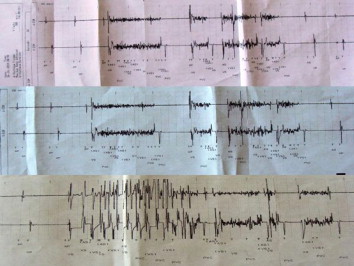Nowadays, increasing medical device applications by developing technology find different places in current era of medicine. Even though these devices have proven themselves in the treatment of a specific disease, we have less information about possible interactions of different devices when used in a same patient. In this report, we present the electromagnetic interactions between a cochlear implant and a previously implanted cardiac pacemaker.We present our experience with cochlear implantation in a 51-year-old male patient who had a DDD mode cardiac PM (Boston Scientific, ALTURA 20 S203 DR) implanted three years ago because of complete atrioventricular block. Due to hearing problems, 3 months ago a cochlear implant (MAESTRO Cochlear Implant System from MED-EL) has been fitted on the same side of the body with the pacemaker. The patient was admitted to our outpatient clinic for PM control. Following PM generator interrogation, we revealed inappropriate atrial and ventricular sensing events at the day cochlear implantation (Fig. 1). The device had detected ventricular tachycardia inappropriately. His surface electrocardiogram showed atrial sensing-ventricular pacing (As-Vp) rhythm. Left lateral and chest radiography demonstrated normally located cardiac PM and cochlear implant. A 24-hour Holter monitoring was performed which showed no clue for any interaction.
After the patient connected to the Pacing System Analyzer again, possible interactions were investigated by reducing the atrial and ventricular sensitivity to the maximum levels (Atrial sensing to 0.5mV vs ventricular sensing to 1.5mV). There was no unusual situation. The external part of the cochlear implant in the upper outer side of pinna was at a distance of 22 cm from the PM battery. When the mobile external part of cochlear implant was approximated to the pacemaker, PM converted to the magnet rhythm at a 3 cm of distance. In the light of this case’s information, we think to be appropriate to convert a DDD pacemaker to DOO/VOO mode in pacemaker-dependent patients during the implantation of cochlear device. Bipolar electrosurgical instruments may also be suitable for PMs. Apart from this measures unless the external part of cochlear implant is placed over the PM battery, an additional electromagnetic interaction does not take place and simultaneous usage of two devices in the same patient were determined to be safe. In a patient with a preexisting cochlear implant, if insertion of a new cardiac pacemaker is needed, selection of the other side may be a suitable option.





